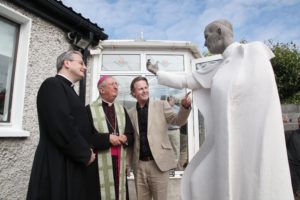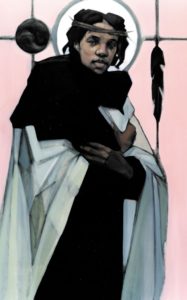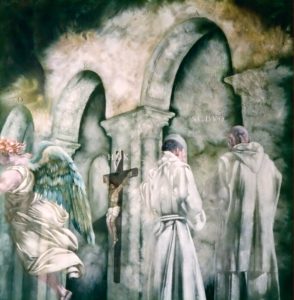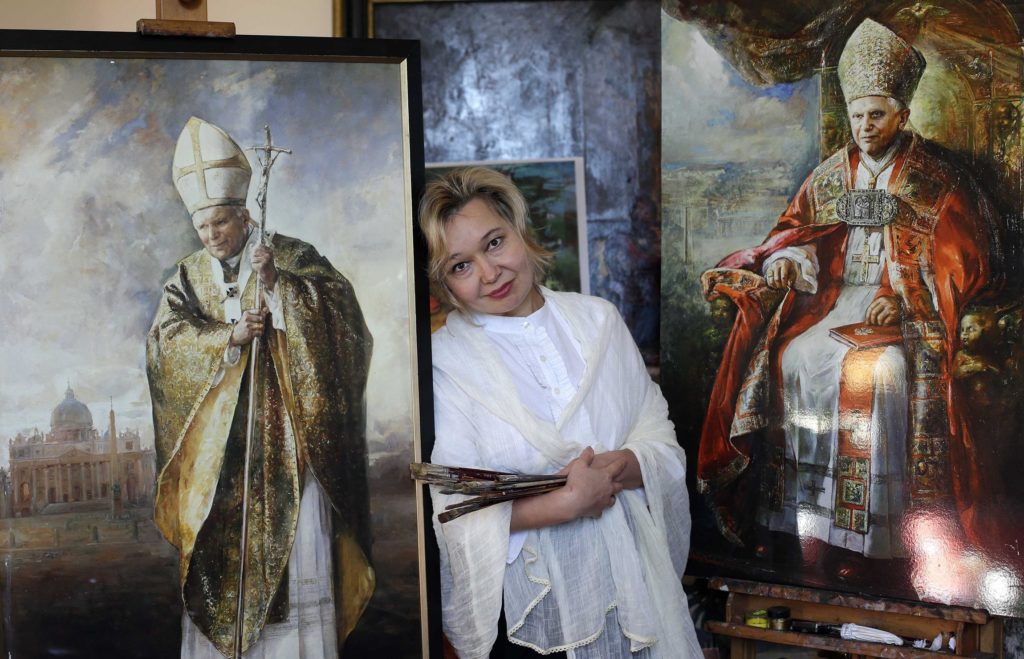It often happens that after seeing the frescoes of the Sistine Chapel, the stained glass of Chartres or the mosaics of San Vitale, pilgrims lament, “Why can’t we make these things anymore?” or “Aren’t there people around who can still do this?”
I respond that it’s not because of a lack of talent; rather, there has been a decline of thoughtful patronage.
The great eras of Christian art — medieval manuscripts, Renaissance paintings, Baroque sculptures — were fueled by people who valued and treasured faith and beauty. While many people love faith and others appreciate beauty today, the two rarely go hand in hand.
In what appears to be a “change of era” for the world and Church, is it too much to ask what part laypeople can play in bringing about a “New Renaissance”?
Many assume that the institutional Church should spearhead such a movement, but it’s been laypeople who have been a critical force for beauty through the ages.
The Medici family, commissioning Donatello’s “David” for their courtyard, patronizing Benozzo Gozzoli’s frescoes, and welcoming the young Michelangelo into their midst, shaped styles, determined demand, and catapulted careers. The Burghers of Bruges vied to hire the most exquisite painters to produce devotional works.
These were investments in both their earthly legacy and spiritual futures. Proud owners displayed their works, and others attempted to emulate the taste of these early “influencers.” The high demand drew more and more talented people to the arts, while experience taught patrons how to elicit the best work from competing artists.
Talent abounds in the world of Catholic art; what is needed now are patrons to promote new faith-based works. Perhaps one of my contributions can be providing a sampler of what is out there. While this is only the tip of the iceberg, my hope is that it will help develop a taste for Catholic art.

Igor Babailov and Natalia Tsarkova are the established gold standard of Catholic artists. They led the Russian brigade of highly trained painters whose drawing skill is only outshone by their handling of color.
Beyond portraits of many famous faces, these two artists have produced their own interpretations of sacred subjects. Babailov’s image of “Mercy” is a haunting work, where he uses his gift for likenesses to put faces to the many stories of suffering around the world. Tsarkova’s “Last Supper” is an astonishing reinterpretation of one of the most well-known subjects in Christian art, engaging the viewer in a new and bold way.
Anthony Visco, Pennsylvania’s response to the Roman Baroque, excels in both painting and sculpture. His statue of “The Guardian Angel of the Unborn” in the Shrine of Our Lady of Guadalupe in Lacrosse, Wisconsin, rivals the work of the 17th-century giants.
Doney MacManus has jump-started a new iconography of St. Joseph in sculpture, while Henry Wingate’s crystalline images offer clarity and intelligibility to his representations of the sacred, the most exalted qualities in post-Tridentine art.
Beyond institutional works, meant to adorn private altars or make a show of generosity for a beloved church, the great patrons of the past found space in their domestic settings for beautiful art as well. Modern museums are filled with portraits of saints, which were intended to grace the walls of a bedroom, study, or living room like a beloved family member.
The principal art form in most homes is photography — framed pictures of oneself alongside one’s family and friends. While that certainly has a place, great patrons of the past balanced their own images with those of people already participating in eternity. They chose to display their name saints or subjects of particular devotion, including Sts. Jerome, Agnes, Francis, and Cecilia. Given that we have many new saints today, there are even more opportunities to fill homes with heavenly trailblazers.

Gwyneth Thompson-Briggs specializes in bringing these holy figures to life, employing meaningful details to encourage deeper contemplation. Neilson Carlin produces images of saints modern and ancient, using a crisp style and jeweled colors reminiscent of stained glass.
On the other side of the Atlantic, the prolific Raul Bersoza from Malaga, Spain, has a stunning body of work centered on images of saints with visual richness that evokes brocaded altar cloths and gem-studded chalices, that accentuate the limpid purity of his holy faces.
Icons, meant for prayer and catechesis, are making a comeback in our era of biblical illiteracy. Shining beacons of truth, they are a solid bridge into the world of art, employing beautiful materials, clean, clear lines, and, for a world that loves puzzles, symbols to be decoded. The iconographer merely serves as a medium between the message and the viewer.
Constantin Brancusi, a modern sculptor who grew up steeped in that visual culture, once said, “Look at things until you really see them. Those who sit close to God have already done so,” summing up the treasure that is the icon.

The American Association of Iconographers is a good source to begin to explore this most ancient of Christian arts.
When thinking of art for the home, still life or landscapes often seem like the best way to cover empty space. Even these “innocuous” works could be leavened with a sacred sense. John Folley’s still lifes with glittering fish scales, glistening grapes, and burnished plates evoke the Eucharist for those with eyes to see. Closer to the spirit of Northern Vanitas are the works of French painter Anne de Saint-Victor.
Parisian-born Rome denizen Philippe Casanova creates interiors of Baroque churches. His rapid brushstroke, descended from the Impressionists, conveys the energy of space with light reflecting off the gilt and stucco.
Images of the Holy Family are another lovely choice for the home — as Florentines once hung “tondi” (“round”), platter-shaped paintings of Mary, Jesus, and John the Baptist to commemorate a new birth. The modern age would do well to celebrate life with similar images.
Cameron Smith uses a Gustav Klimt-like sumptuousness in his scenes, though their real power comes from the authenticity of the expressions and interactions. Janet McKenzie’s paintings are haunting, her palette of taupe, lavender, and rose calms the eye but also adds a solemn sense of mystery to her scenes. McKenzie celebrates the Christian heritage of Africa, from her representations of St. Josephine Bakhita and the plight of trafficked African women to her powerful images of black fatherhood, especially in her portrayal of St. Joseph.

In the history of Western art, the Classical style was always balanced by edgier artists, who experimented with new techniques and different perspectives. Just as Caravaggio stood out in the age of the Carracci, so there are today many artists who are challenging the mainstream naturalistic tendency of contemporary art.
Three examples of this promising trend are Hélène Legrand, whose powerful Michelangelo’s bodies dissolve into light or mesmerizing color; Daniel Bonnell, whose swirling brushstroke compels the viewer to look more closely to try to perceive the order within apparent chaos, and Jean Prachinetti, who animates his structured spaces with mysterious mists and angelic beings.
There are many more gifted artists out there than those I’ve mentioned. More importantly, even a few people are trying to help connect them to patrons.
As we enter into this period of preparation and contemplation that is Lent, perhaps we could take some time to reflect on how to bring the gift of art back into the world to proclaim the good news of the Word made Flesh.

